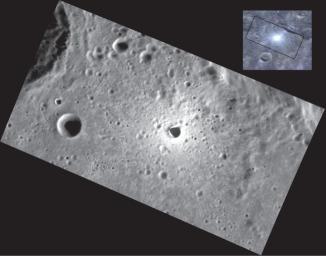This high-resolution image reveals the shape of a small, fresh crater on Mercury. In the inset color image, which is a composite of the MDIS Wide Angle Camera filters with the 1000-nm filter depicted in red, the 750-nm filter depicted in green, and the 430-nm filter depicted in blue, this crater is so bright relative to the surroundings that it appears to be close to the same size as the crater to its west. However, from this main image, it is clear that this bright crater is less than half the size of its neighbor. Small craters like this are extremely valuable scientifically, as they excavate material that has been sheltered from the harsh space environment and what is known as space weathering. By studying their spectral properties, scientists can begin to understand both the composition of the surface and how space weathering alters the uppermost surface of the planet.
This image was acquired as a high-resolution targeted observation. Targeted observations are images of a small area on Mercury's surface at resolutions much higher than the 200-meter/pixel morphology base map. It is not possible to cover all of Mercury's surface at this high resolution, but typically several areas of high scientific interest are imaged in this mode each week.
Date acquired: August 02, 2011
Image Mission Elapsed Time (MET): 220762382
Image ID: 581250
Instrument: Narrow Angle Camera (NAC) of the Mercury Dual Imaging System (MDIS)
Center Latitude: 42.37°
Center Longitude: 8.06° E
Resolution: 45 meters/pixel
Scale: The small, fresh crater is about 3.5 km (2.2 miles) across
Incidence Angle: 67.2°
Emission Angle: 57.0°
Phase Angle: 124.2°
The MESSENGER spacecraft is the first ever to orbit the planet Mercury, and the spacecraft's seven scientific instruments and radio science investigation are unraveling the history and evolution of the Solar System's innermost planet. Visit the Why Mercury? section of this website to learn more about the key science questions that the MESSENGER mission is addressing. During the one-year primary mission, MDIS acquired 88,746 images and extensive other data sets. MESSENGER is now in a year-long extended mission, during which plans call for the acquisition of more than 80,000 additional images to support MESSENGER's science goals.
For information regarding the use of images, see the MESSENGER image use policy.

 Planetary Data System
Planetary Data System












